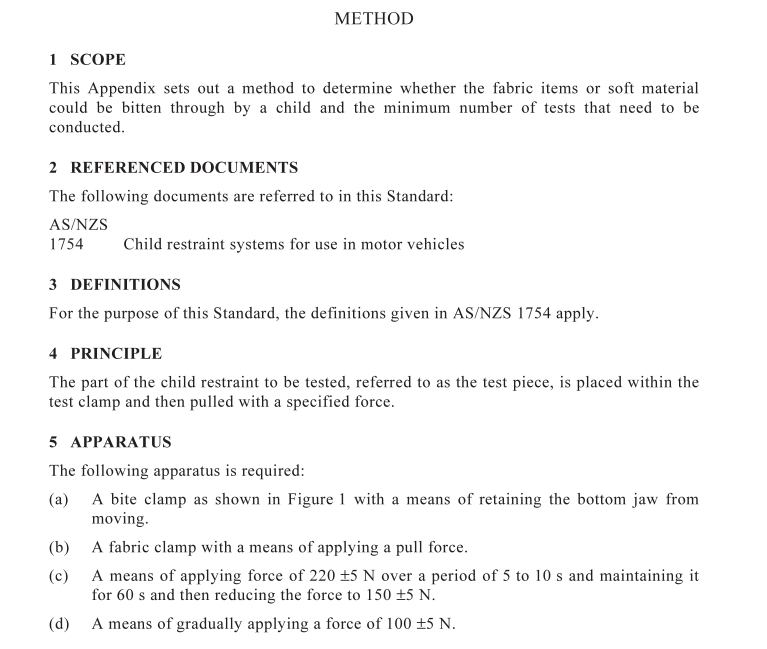AS NZS 3629.10 pdf download – Methods of testing child restraints Method 10: Bite test

AS NZS 3629.10 pdf download – Methods of testing child restraints Method 10: Bite test
1 SCOPE
This Appendix sets out a method to determine whether the fabric items or soft material could be bitten through by a child and the minimum number of tests that need to be conducted.
2 REFERENCED DOCUMENTS
The following documents are referred to in this Standard:
AS/NZS
1754 Child restraint systems for use in motor vehicles
3 DEFINITIONS
For the purpose of this Standard, the definitions given in AS/NZS 1754 apply.
4 PRINCIPLE
The part of the child restraint to be tested, referred to as the test piece, is placed within the test clamp and then pulled with a specified force.
5 APPARATUS
The following apparatus is required:
(a) A bite clamp as shown in Figure 1 with a means of retaining the bottom jaw from moving.
(b) A fabric clamp with a means of applying a pull force.
(c) A means of applying force of 220 ±5 N over a period of 5 to 10 s and maintaining it for 60 s and then reducing the force to 150 ±5 N.
(d) A means of gradually applying a force of 100 ±5 N.
(e) A means to keep water at 35°C to 40°C.
(f) A means of measuring temperature.
(g) A suitable timing device.
(h) A suitable means of measuring length with an accuracy of 0.2 mm.
6 PROCEDURE
The procedure shall be as follows:
(a) Remove item(s) to be tested from the child restraint.
(b) Test wet or dry as appropriate. For wet test, soak the test piece in warm water at 35°C to 40°C for at least 15 minutes.
(c) For wet test, take one item from the water container and shake off excess water. For wet and dry tests, position the test piece between the upper and the lower plates of the bite clamp such that when a force is applied to the loading point, the teeth close and the effect would resemble a child’s bite. Apply the fabric clamp so as to apply the force to pull the fabric out of the bite clamp. See the setup in Figure 2 and position 1 shown in Figure 3.
(d) Evenly and gradually apply a force F1 (see Figure 2) of 200 ±5 N to the loading point in a direction perpendicular to the upper surface of the top plate, over a period of 5 to 10 s and maintain it for a period of 60 s.
(e) After applying the 200 N loading, evenly and gradually reduce the load to 150 ±5 N to the bite clamp, over a period of 5 s and maintain.
(f) After the load of 150 N has been maintained for at least 20 s, gradually apply a force F2 (see Figure 2) of 100 ±5 N to pull the fabric out of the bite clamp.
(g) Maintain the 150 N and 100 N loads for up to a further 30 s unless the test piece moves through the bite clamp by more than 20 mm. If the test piece slides through the bite clamp by more than 12 mm then move to Step (i). (h) Observe whether a piece of fabric has been stripped from its backing or formed pieces. The part that is stripped or the piece shall be flattened out and the area measured. (i) Repeat Steps (b) to (h) for positions 2 and 3 in Figure 3.
(j) For wet test, place samples back in the warm water between tests for at least 1 minute.
(k) Repeat Steps (b) to (j) for each type of item.
7 REPORT The following information shall be reported and, if appropriate, noted on a diagram of the item tested:
(a) Description of the part that was tested and the test directions.
(b) Whether the fabric formed pieces or was removed from its backing and the area this piece of fabric exceeded the size allowed by AS/NZS 1754. (c) A reference to this test method, i.e. AS/NZS 3629.10.









